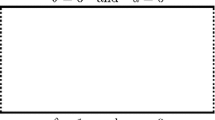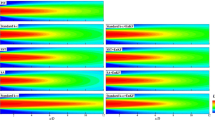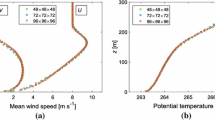Abstract
Because the nonlinearity of actual physical processes can be expressed more precisely by the introduction of a nonlinear term, the weakly nonlinear Prandtl model is one of the most effective ways to describe the pure katabatic flow (no background flow). Features of the weak nonlinearity are reflected by two factors: the small parameter ε and the gradually varying eddy thermal conductivity. This paper first shows how to apply the Wentzel–Kramers–Brillouin (WKB) method for the approximate solution of the weakly nonlinear Prandtl model, and then describes the retrieval of gradually varying eddy thermal conductivity from observed wind speed and perturbed potential temperature. Gradually varying eddy thermal conductivity is generally derived from an empirical parameterization scheme. We utilize wind speed and potential temperature measurements, along with the variational assimilation technique, to derive this parameter. The objective function is constructed by the square of the differences between the observation and model value. The new method is validated by numerical experiments with simulated measurements, revealing that the order of the root mean squre error is 10–2 and thus confirming the method’s robustness. In addition, this method is capable of anti-interference, as it effectively reduces the influence of observation error.
Similar content being viewed by others
References
Arnold, C. P. Jr, and C. H. Dey, 1986: Observing-systems simulation experiments: Past, present, and future. Bull. Amer. Meteor. Soc., 67, 687–695, doi: 10.1175/1520-0477(1986)067<0687:OSSEPP>2.0.CO;2.
Axelsen, S. L., and H. van Dop, 2009: Large-eddy simulation of katabatic winds. Part 2: Sensitivity study and comparison with analytical models. Acta Geophys., 57, 837–856, doi: 10.2478/s11600-009-0042-5.
Baklanov, A. A., B. Grisogono, R. Bornstein, et al., 2011: The nature, theory, and modeling of atmospheric planetary boundary layers. Bull. Amer. Meteor. Soc., 92, 123–128, doi: 10.1175/2010BAMS2797.1.
Barthélemy, A., H. Goosse, P. Mathiot, et al., 2012: Inclusion of a katabatic wind correction in a coarse-resolution global coupled climate model. Ocean Modell., 48, 45–54, doi: 10.1016/j.ocemod.2012.03.002.
Buzzi, M., M. W. Rotach, M. Holtslag, et al., 2011: Evaluation of the COSMO-SC turbulence scheme in a shear-driven stable boundary layer. Meteor. Z., 20, 335–350, doi: 10.1127/0941-2948/2011/0050.
De Ridder, K., D. Lauwaet, and B. Maiheu, 2015: UrbClim—A fast urban boundary layer climate model. Urban Climate, 12, 21–48, doi: 10.1016/j.uclim.2015.01.001.
Denby, B., 1999: Second-order modeling of turbulence in kata-batic flows. Bound.-Layer Meteor., 92, 65–98, doi: 10.1023/A:1001796906927.
Egger, J., 1990: Thermally forced flows: Theory. Atmospheric Processes over Complex Terrain. Blumen W., Ed. Boston, MA, Amer. Meteor. Soc., 43–58.
Epifanio, C. C., 2007: A method for imposing surface stress and heat flux conditions in finite-difference models with steep terrain. Mon. Wea., Rev., 135, 906–917, doi: 10.1175/MWR3297.1.
Gao, J. D., C. J. Qiu, and J. F. Chou, 1995: The sensitivity influence of numerical model initial values on four-dimensional assimilation—Study based on Lorenz system. Acta Meteor. Sinica, 9, 278–287.
Grisogono, B., 2003: Post-onset behaviour of the pure katabatic flow. Bound.-Layer Meteor., 107, 157–175, doi: 10.1023/A:1021511105871.
Grisogono, B., and J. Oerlemans, 2001a: Katabatic flow: Analytic solution for gradually varying eddy diffusivities. J. Atmos. Sci., 58, 3349–3354, doi: 10.1175/1520-0469(2001)058<3349:KFASFG>2.0.CO;2.
Grisogono, B., and J. Oerlemans, 2001b: A theory for the estimation of surface fluxes in simple katabatic flows. Quart. J. Roy. Meteor. Soc., 127, 2725–2739, doi: 10.1002/qj.49712757811.
Grisogono, B., and J. Oerlemans, 2002: Justifying the WKB approximation in pure katabatic flows. Tellus, 54, 453–463, doi: 10.3402/tellusa.v54i5.12166.
Grisogono, B., and S. L. Axelsen, 2012: A note on the pure katabatic wind maximum over gentle slopes. Bound.-Layer Meteor., 145, 527–538, doi: 10.1007/s10546-012-9746-1.
Grisogono, B., T. Jurlina, Ž. Večenaj, et al., 2015: Weakly nonlinear Prandtl model for simple slope flows. Quart. J. Roy. Meteor. Soc., 141, 883–892, doi: 10.1002/qj.2406.
Hu, X. M., F. Q. Zhang, and J. W. Nielsen-Gammon, 2010: Ensemble-based simultaneous state and parameter estimation for treatment of mesoscale model error: A real-data study. Geophys. Res. Lett., 37, L08802, doi: 10.1029/2010GL043017.
Huang, S. X., J. Xiang, H. D. Du, et al., 2005: Inverse problems in atmospheric science and their application. J. Phys. Conf. Ser., 12, 45–57, doi: 10.1088/1742-6596/12/1/005.
Huang, S. X., X. Q. Cao, H. D. Du, et al., 2006: Retrieval of atmospheric and oceanic parameters and the relevant numerical calculation. Adv. Atmos. Sci., 23, 106–117, doi: 10.1007/s00376-006-0011-8.
Ingel, L. K., 2011: Toward a nonlinear theory of katabatic winds. Fluid Dyn., 46, 505–513, doi: 10.1134/S0015462811040016.
Jeričević, A., L. Kraljević, B. Grisogono, et al., 2010: Parameterization of vertical diffusion and the atmospheric boundary layer height determination in the EMEP model. Atmos. Chem. Phys., 10, 341–364, doi: 10.5194/acp-10-341-2010.
Kaipio, J., and E. Somersalo, 2005: Statistical and Computational Inverse Problems. Springer, 357 pp.
Lorenc, A. C., 1988: A practical approximation to optimal four-dimensional objective analysis. Mon. Wea. Rev., 116, 730–745, doi: 10.1175/1520-0493(1988)116<0730:APATOF>2.0.CO;2.
Mahrt, L., 1982: Momentum balance of gravity flows. J. Atmos. Sci., 39, 2701–2711, doi: 10.1175/1520-0469(1982)039<2701:MBOGF>2.0.CO;2.
Mahrt, L., 1998: Stratified atmospheric boundary layers and breakdown of models. Theoret. Comput. Fluid Dyn., 11, 263–279, doi: 10.1007/s001620050093.
Mo, R. P., 2013: On adding thermodynamic damping mechanisms to refine two classical models of katabatic winds. J. Atmos. Sci., 70, 2325–2334, doi: 10.1175/JAS-D-12-0256.1.
Navon, I. M., 1998: Practical and theoretical aspects of adjoint parameter estimation and identifiability in meteorology and oceanography. Dyn. Atmos. Oceans, 27, 55–79, doi: 10.1016/S0377-0265(97)00032-8.
Nielsen-Gammon, J. W., X. M. Hu, F. Q. Zhang, et al., 2010: Evaluation of planetary boundary layer scheme sensitivities for the purpose of parameter estimation. Mon. Wea. Rev., 138, 3400–3417, doi: 10.1175/2010MWR3292.1.
Salvador, N., N. C. Reis Jr, J. M. Santos, et al., 2016: Evaluation of weather research and forecasting model parameterizations under sea-breeze conditions in a North Sea coastal environment. J. Meteor. Res., 30, 998–1018, doi: 10.1007/s13351-016-6019-9.
Shapiro, A., B. Burkholder, and E. Fedorovich, 2012: Analytical and numerical investigation of two-dimensional katabatic flow resulting from local surface cooling. Bound.-Layer Meteor., 145, 249–272, doi: 10.1007/s10546-011-9685-2.
Shapiro, A., E. Fedorovich, and S. Rahimi, 2016: A unified theory for the Great Plains nocturnal low-level jet. J. Atmos. Sci., 73, 3037–3057, doi: 10.1175/JAS-D-15-0307.1.
Smith, C. M., and E. D. Skyllingstad, 2005: Numerical simulation of katabatic flow with changing slope angle. Mon. Wea. Rev., 133, 3065–3080, doi: 10.1175/MWR2982.1.
Stiperski, I., I. Kavčič, B. Grisogono, et al., 2007: Including Coriolis effects in the Prandtl model for katabatic flow. Quart. J. Roy. Meteor. Soc., 133, 101–106, doi: 10.1002/qj.19.
Sun J. L., D. H. Lenschow, L. Mahrt, et al., 2013: The relationships among wind, horizontal pressure gradient, and turbulent momentum transport during CASES-99. J. Atmos. Sci., 70, 3397–3414, doi: 10.1175/JAS-D-12-0233.1.
Tan, Z. M., J. Fang, and R. S. Wu, 2006: Nonlinear Ekman layer theories and their applications. Acta Meteor. Sinica, 20, 209–222.
Tosaka, N., K. Onoshi, and M. Yamamoto, 1999: Mathematical Approach and Solution Methods for Inverse Problems: Inverse Analysis of Partial Differential Equation. University of Tokyo Press, 294 pp. (in Japanese)
van den Broeke, M. R., 1997: Structure and diurnal variation of the atmospheric boundary layer over a mid-latitude glacier in summer. Bound.-Layer Meteor., 83, 183–205, doi: 10.1023/A:1000268825998.
Yan, B., and S. X. Huang, 2014: Variational regularization method of solving the Cauchy problem for Laplace’s equation: Innovation of the Grad–Shafranov (GS) reconstruction. Chinese Phys. B, 23, 650–655, doi: 10.1088/1674-1056/23/10/109402.
Zhao, X. F., and S. X. Huang, 2012: Estimation of atmospheric duct structure using radar sea clutter. J. Atmos. Sci., 69, 2808–2818, doi: 10.1175/JAS-D-12-073.1.
Author information
Authors and Affiliations
Corresponding author
Additional information
Supported by the National Natural Science Foundation of China (41575026).
Rights and permissions
About this article
Cite this article
Yan, B., Huang, S. & Feng, J. Retrieval of eddy thermal conductivity in the weakly nonlinear Prandtl model for katabatic flows. J Meteorol Res 31, 965–975 (2017). https://doi.org/10.1007/s13351-017-7025-2
Received:
Accepted:
Published:
Issue Date:
DOI: https://doi.org/10.1007/s13351-017-7025-2




